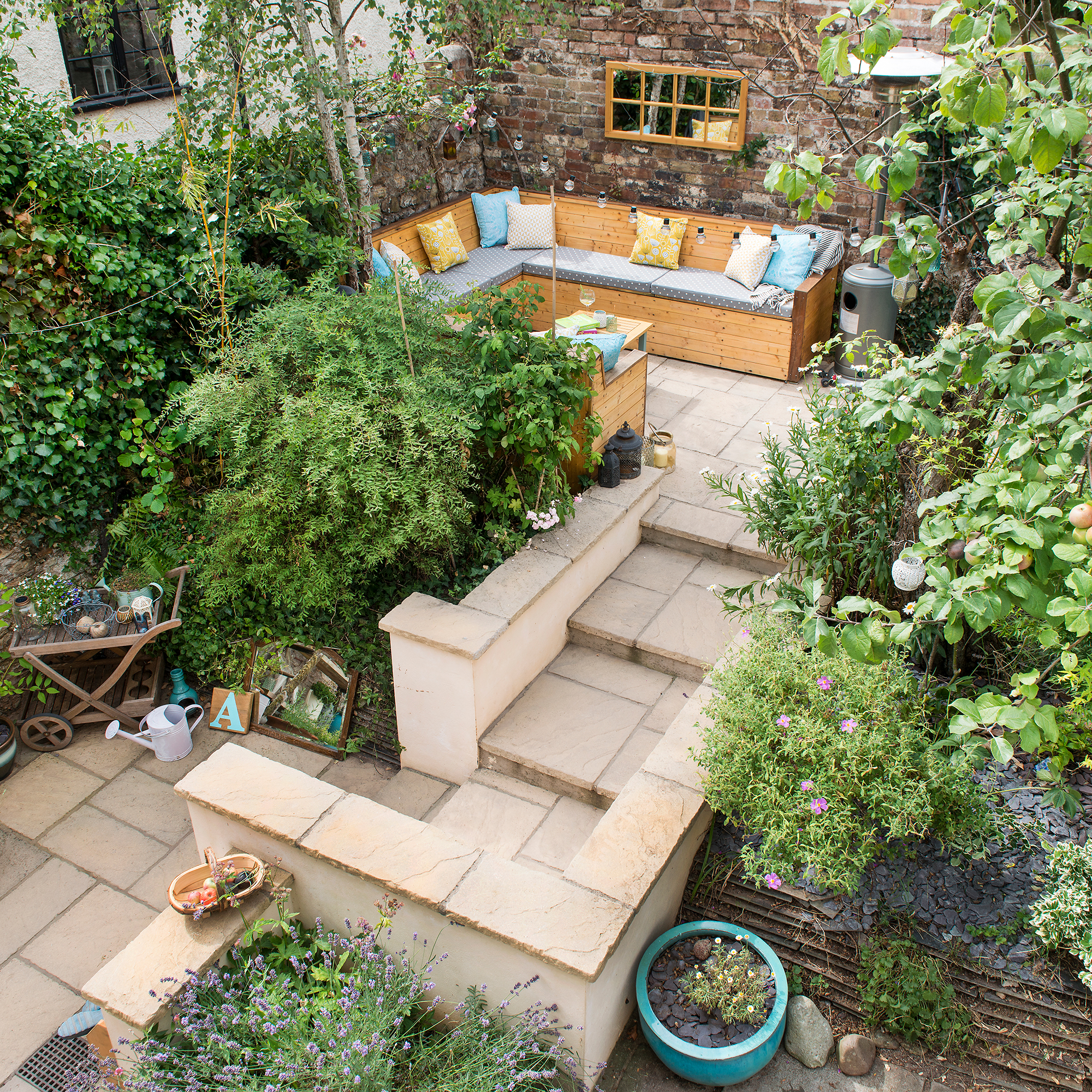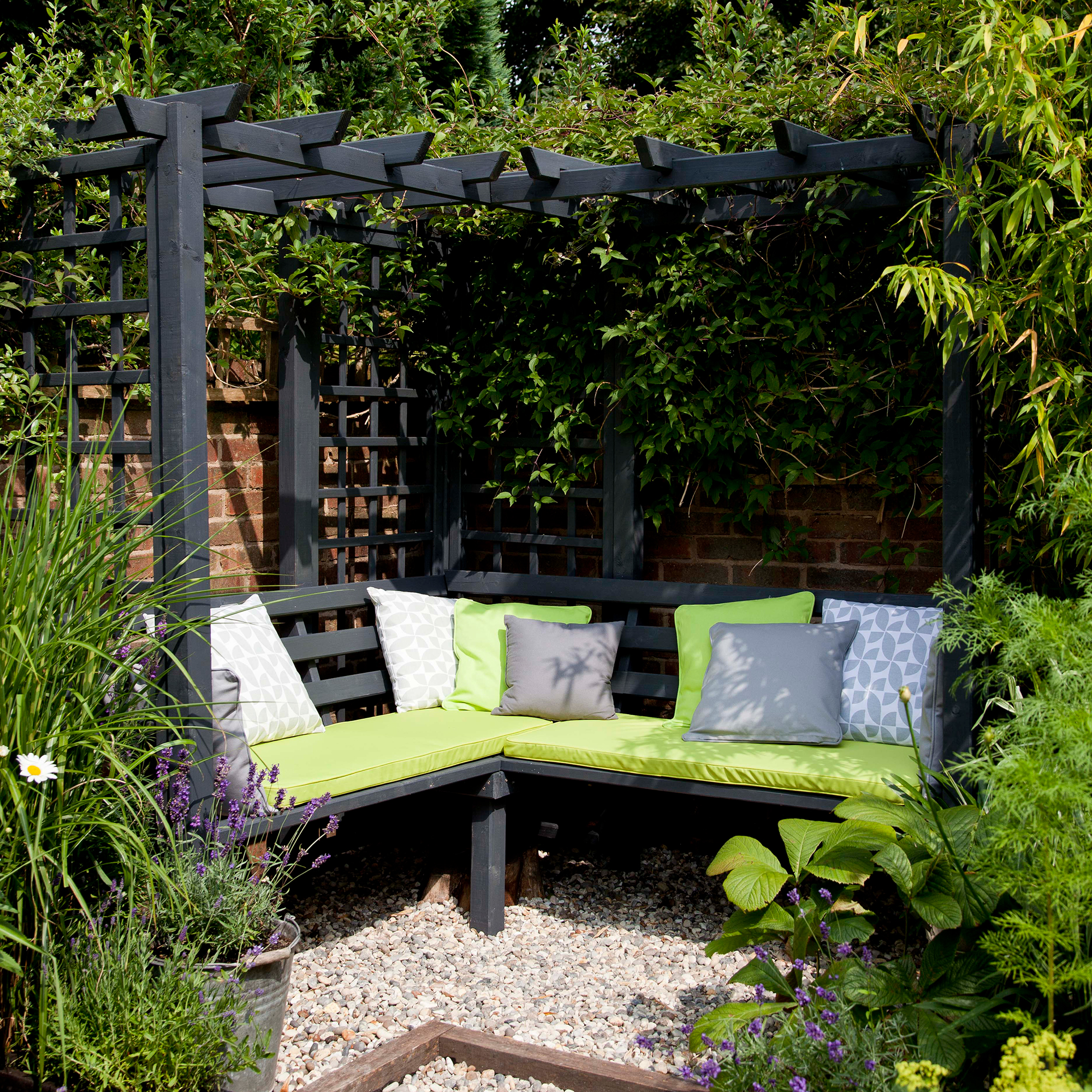Terraced garden ideas - 10 ways to create a lively multi-dimensional outdoor space
Turn a disjointed space into a beautiful tiered garden


A terraced garden can turn a tricky, disjointed garden into a lively multi-dimensional outdoor living space that’s so much easier to use and enjoy. Terracing is the ideal way to deal with a sloping plot, because it divides it up into level and manageable areas.
When you’re considering your terraced garden ideas, give each separate areas a specific purpose; for instance, relaxing, socialising, dining, storage, playing, even adding a water feature or a wildlife pond.
Terracing is also a great way to tackle an existing arrangement of different messy levels, pulling together flat areas, retaining walls and steps into an attractive and cohesive whole that will have the ‘wow factor’.
Terraced garden ideas
Once you decide to take the plunge, you will be brimming with garden ideas for your new terraced garden because you’re dealing with the space in a multi-dimensional way. Think not just up and down the incline, but also out forward into the potential of the space above ground level, and along each side too. Suddenly, you will have so much space to play with!
Here are some amazing terraced garden tips to inspire you.
1. Work with existing walls

Some terraced gardens will have at least one existing wall to work off. This might be the back or the front of the house, a garden rear wall or fence. Others will be free-standing and exist only in their own right as a way of creating movement from one level of a garden to another.
If you are working off existing walls, a good tip is to keep the materials you choose for the terracing similar to those that the house is constructed from or create a confident design-led contrast – for example, anthracite grey slate, against white rendered house walls.
Get the Ideal Home Newsletter
Sign up to our newsletter for style and decor inspiration, house makeovers, project advice and more.
2. Use decking to pull everything together

If you’re dealing with several levels, awkward corners and the surroundings just look a little messy, decking provides a seamless visual backdrop. It pulls each aspect of a terraced garden together, including the steps. Decking also provides an easy-to-maintain finish and if fitted correctly, should feel very solid and secure.
Pay special attention to neatly finishing off the edges of each decked element as they will be on show from all angles of the terraced garden.
3. Use tiles for contemporary cool

If you're not a fan of decking, tiles can help give your landscaping ideas a modern spin. 'If you prefer the modern feel and want to achieve a contemporary look in your terraced garden, large neutral-coloured stone tiles can do just that,' says Harry Patte-Dobbs, outdoor design expert at GardenBuildingsDirect.
'Make sure to go for tiles which have a strong and durable surface, are crack-resistant, weed-proof and are made of a permeable material to avoid puddles and provide drainage.'
4. Introduce elements for shade and shelter

If your terraced garden is south-facing, the top levels will be exposed and may become uncomfortable to sit on when the weather is hot and sunny. So you should look to include garden shade ideas such as pergolas planted with vigorous climbers such as grapevines – they will love the sun – clematis and honeysuckle. Or if there is a handy wall to secure it to, and the spot isn’t too windy, fix a simple sail.
5. Include raised beds

Some terraced gardens have no seating or relaxation areas at all but are filled with plants in raised beds, typically constructed from sleepers or stone blocks for a natural look. This is an excellent use of space and will expand the planting area of your garden allowing space to grow flowers and vegetables.
Planning the beds does need care. Consider draining, as too much retained water could make the terracing unstable. If you’re planting in a terraced garden, think about placing plants which require more shade and watering towards the bottom of the terracing as rainwater will run downhill and pool.
6. Bring in a living wall

Once you have the terracing set in place, there are lots of easy garden ideas to bring it alive. 'I love using sleepers to create steps, but even better yet, to create a green oasis, use the vertical sides of the sleepers as a surface for a living wall,' says Tom Luck, a gardening expert at Growing Revolution.
'You can fill your living wall troughs with textural and colourful flowers and foliage to add additional depth and life to your terraced garden.'
7.Consider the view from all angles

When you’re thinking about how to plan how to plan a garden it’s important to picture what it’s going to look like from all angles. This is super-important with a terraced garden because its shape and form will dominate your outdoor space.
If you’re leading off your living room, for example, co-ordinate the colour scheme and style of outdoor furniture. If it’s terraced front garden ideas you’re looking for, consider stepping down planters on each side of the central steps, to create an entrance to your home with impact, colour and fragrance.
8. Include a slope to connect levels

Usually, different levels in a terraced garden are linked by adding steps. However, if you or a family members have mobility issues, or young children will be enjoying the terraced garden, another idea is to devise a sloping path and/or ramps instead.
You can include multiple access routes to different levels if you have the space. However, don’t crowd the area with too many steps and slopes as it will cut down on useable space, plus the can be quite expensive to excavate and build.
9. Give each terraced level a purpose

This is the fun bit. Sketch out how you see your ideal terraced garden working before you even begin to think about the precise sizing of specific areas. Some themes are fairly consistent; a place to sit, positioned to maximise the sun at certain times of the day or an amazing view, should be part of every terraced garden.
However, remember, that each terraced garden is unique. You could include some shed ideas or even turn one part of the terrace into a dedicated hot tub space.
10. Source natural materials for terrace walls

A terraced garden sits squarely in the landscape, so as a general rule of thumb it is best to use natural, or natural-appearing, materials to bring your ideas to life. These can be timber sleepers (new or reclaimed, depending on whether you’re after a modern or rustic style), treated timber or realistic hard-wearing composite for decking, or stone or slate for walls and other retaining features.
Garden designer Robert Hughes takes a practical approach to materials. 'The most structurally-sound material would be my suggestion for a terraced garden. Who wants to spend all that money for it to fail after several years?' He favours concrete block-constructed walls which can then be clad in natural materials.
'They can be faced with all sorts of beautiful materials, from cedar to porcelain or natural stone walling/cladding.'
How do I arrange my terrace garden?
With most gardens, you can choose where you want to plant certain flowers and arrange seating areas as you wish. But with a terrace garden you have less choice because you have to go with the position of the slope or incline. So this might mean that you’re looking for inspiring north-facing garden ideas as some of your terrace garden might be in shade for much of the day.
How do I improve the slope in my garden?
If you’re looking for sloping garden ideas bringing in terracing is the ideal solution. It will make the garden so much easier to use and enjoy. But sometimes the slope might be too steep, or too gentle and you will need to intervene to get it just right.
With a very steep slope, you may have to include retaining walls or gambion baskets (wire cages filled with pebbles) to avoid having to excavate too much earth, or you could mound up the spare earth at each side to help contour out the slope; you will need the advice of a structural engineer.
If you want a terraced garden and your slope is not steep enough, depending on the site, it is possible to dig out a new bottom terrace layer at a lower level. This type of digging is less disruptive and cheaper than digging into a steep slope. The spare soil can be repurposed elsewhere in the garden, including -mixed with a good quality compost - raised beds as part of your terraced planting scheme.
How do you terrace a garden?
If your gradient is fairly gentle, the simplest way to terrace a garden in the UK is to install timber sleepers into the ground at regular distances to create the ‘rooms’ you want, says garden designer Robert Hughes. Then you can decide whether to keep the flat surfaces lawned or have them decked, paved or gravelled.
Terracing a steeper slope will require professional input; so you might want to consider how much a garden designer costs to get the job planned properly. Alternatively, you can also look into how much garden landscaping costs to ensure that the work is carried out professionally and safely.

Jayne Dowle is an award-winning freelance gardening, homes and property writer who writes about everything from swimming ponds to skyscraper apartments, for publications including Sunday Times Home, Times Bricks & Mortar, Grand Designs, House Beautiful and The Spectator. Awarded the Garden Journalist of the Year accolade at the Property Press Awards in 2021, she has a degree in English Language and Literature from the University of Oxford and a lifelong love of homes, interiors and gardens.
-
 I’ve been looking for a new signature scent for my home and The White Company's new fragrance is the exact summer holiday smell I needed
I’ve been looking for a new signature scent for my home and The White Company's new fragrance is the exact summer holiday smell I neededSantorini smells fresh, summery and sophisticated
By Kezia Reynolds
-
 How to remove algae from garden walls in five steps – and the cleaning product experts rave about for tackling it fast
How to remove algae from garden walls in five steps – and the cleaning product experts rave about for tackling it fastExperts share their top tips for getting garden walls algae-free
By Katie Sims
-
 I swore I would never choose a flat sheet over a fitted sheet – but this advice from a bedding expert just changed my mind
I swore I would never choose a flat sheet over a fitted sheet – but this advice from a bedding expert just changed my mindWhy I'm now a 'flat sheet' convert
By Amy Lockwood